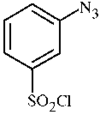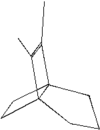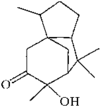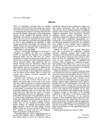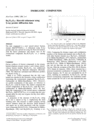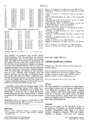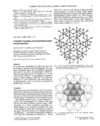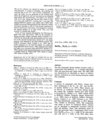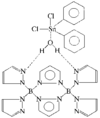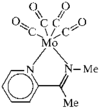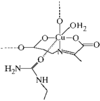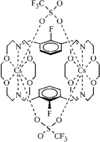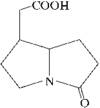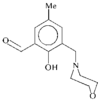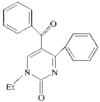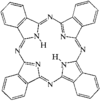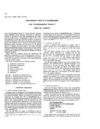issue contents
January 1999 issue

cif-access (metal-organic compounds)
Download citation


Download citation


In the crystals of μ-[N:N';N:N'-bis(2-chloro-1,3-xylyl)bis(di-aza-18-crown-6)]disilver(I) bis(trifluoromethanesulfonate), each AgI ion is coordinated primarily by two N atoms in an almost linear fashion and further coordinated by four weaker contacts to the O atoms of the diaza-18-crown-6 unit.
cif-access (inorganic compounds)
Download citation


Download citation


The Fe atom is coordinated to the exocyclic double bonds of the organic ligand and the carbonyl groups in a pentagonal fashion, with the carbonyl groups in a piano-chair conformation. The Fe—C distances correspond generally to those of the butadiene analogue [Mills & Robinson (1963). Acta Cryst. 16, 758–761].
cif-access (organic compounds)
Download citation


Download citation


The space group revision of the title compound [Marsh (1997). Acta Cryst. B53, 317–322] is confirmed. The structure is properly described in I4c2 with Z' = 1/2 rather than in Cc with Z' = 2.
Download citation


Download citation


The crystal structure of (2SR,5RR,6RR,9SR)-1,2,5,6,9,10-hexachlorodecane, prepared by chlorine addition to the double bonds of 1,5,9-decatriene, is presented. The molecule has C2 symmetry.
Download citation


Download citation


The title compound is used as a raw material for the esterification of aliphatic and aromatic mono- and polyfunctional alcohols. Mono-, di- and triazido compounds, which are applied, for example, in the process of lithographic structuring of polymers, are prepared in the same way.
Download citation


Download citation


The title compound belongs to the group of [3.2.2]propellanes. The bond angles inside the cyclobutane and cyclobutene units involving the C1 and C2 atoms of the central bridge are less than 90°.
Download citation


Download citation


The title compound is found to exist as a dimer in the solid state due to a hydrogen bond between the hydroxy group of one molecule and the carbonyl group of another.
Download citation


Download citation


The molecular structures of the title compounds are similar to each other and suggest almost no electron transfer from the dithiacyclopentene-2-thione or 2-one group to the indandione group.
Download citation


Download citation


The two phenyl rings make a dihedral angle of 73.5(1)°, indicating the non-planarity of the molecule. The orientation of the methanesulfonanilide moiety with respect to the phenyl ring is given by the C—S—N—C torsion angle of -69.2(2)°. Molecules are linked into pairs by N—H⋯O hydrogen bonding over an inversion centre.
editorial
Free 

inorganic compounds
Download citation


Download citation


The Rietveld refinement of a barium titanate, Ba4Ti12O27, which is isostructural with Ba4Al2Ti10O27 and Ba4ZnTi11O27, is reported. The structure is rather compact, with narrow channels along the b axis.
Download citation


Download citation


Stacked double chains containing Ca1O7 and Ca2O6 polyhedra are linked to form a three-dimensional framework by B2O5 groups.
Download citation


Download citation


The isomorphous title compounds are newly discovered double-anion salts containing ZnCl42– and NO3– ions. The structure consists of rows of nitrate ions parallel to a, surrounded by cylinders of cations, which in turn are surrounded by concentric cylinders of tetrachlorozincate ions.
Download citation


Download citation


The bloedite-type title compound consists of parallel layers built up of MgO2(H2O)4 and NaO4(H2O)2 octahedra. Layers are interconnected through SO4 tetrahedra and hydrogen bonds.
Download citation


Download citation


In the title salt, the anion has the Anderson structure with crystallographic 3m symmetry. The unique cation site is occupied by disordered Na+ and Co2+ ions. The anions form layers perpendicular to the c axis which are separated by double layers of cations.
Download citation


Download citation


The single-crystal structure determination of potassium tetrabromoaurate(III), KAuBr4, in the centrosymmetric space group P21/c is reported. The AuBr4– anions are nearly square planar.
Download citation


Download citation


A powder diffraction study of BaCaGa4O8 reveals that GaO4 tetrahedra are arranged in a derivative structure of tridymite. The type of arrangement of GaO4 tetrahedra has not been found previously among compounds with the stuffed tridymite structure.
Download citation


Download citation


BaNb4-xTixO6 is isostructural with BaNb4O6, i.e. it contains alternating NbO and perovskite-type single slabs. The NbO slabs can also be described as layers of Nb6O12 clusters, condensed via corner sharing among the Nb6 octahedra.
metal-organic compounds
Download citation


Download citation


Download citation


Download citation


Download citation


Download citation


Download citation


Download citation


Download citation


Download citation


Download citation


Download citation


Download citation


Download citation


Download citation


Download citation


Download citation


Download citation


Download citation


Download citation


Download citation


Download citation


Download citation


Download citation


Download citation


Download citation


Download citation


Download citation


Download citation


Download citation


Download citation


Download citation


Download citation


Download citation


Download citation


Download citation


Download citation


Download citation


Download citation


Download citation


Download citation


Download citation


Download citation


Download citation


Download citation


Download citation


organic compounds
Download citation


Download citation


Download citation


Download citation


Download citation


Download citation


Download citation


Download citation


Download citation


Download citation


Download citation


Download citation


Download citation


Download citation


Download citation


Download citation


Download citation


Download citation


Download citation


Download citation


Download citation


Download citation


Download citation


Download citation


Download citation


Download citation


Download citation


Download citation


Download citation


Download citation


Download citation


Download citation


Download citation


Download citation


Download citation


Download citation


Download citation


Download citation


Download citation


Download citation


Download citation


Download citation


Download citation


Download citation


Download citation


Download citation


Download citation


Download citation


Download citation


Download citation


Download citation


Download citation


Download citation


Download citation


Download citation


Download citation


Download citation


Download citation


Download citation


Download citation


international union of crystallography
Free 



 journal menu
journal menu















